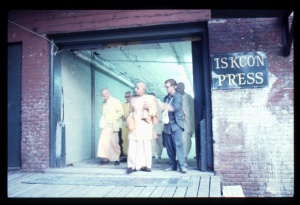CC Adi 13.113 (1975)

A.C. Bhaktivedanta Swami Prabhupada
TEXT 113
- vyāghra-nakha hema-jaḍi, kaṭi-paṭṭasūtra-ḍorī
- hasta-padera yata ābharaṇa
- citra-varṇa paṭṭa-sāḍī, buni photo paṭṭapāḍī,
- svarṇa-raupya-mudrā bahu-dhana
SYNONYMS
vyāghra-nakha—tiger nails; hema-jaḍi—set in gold; kaṭi-paṭṭasūtra-ḍorī—silken thread for the waist; hasta-padera—of the hands and legs; yata—all kinds of; ābharaṇa—ornaments; citra-varṇa—printed with varieties of colors; paṭṭa-sāḍī—silken sārīs; buni—woven; photo—small jackets for children; paṭṭa-pāḍī—with embroidery of silk; svarṇa—gold; raupya—silver; mudrā—coins; bahu-dhana—all kinds of riches.
TRANSLATION
There were also tiger nails set in gold, waist decorations of silk and lace, ornaments for the hands and legs, nicely printed silken sārīs and a child's garment, also made of silk. Many other riches, including gold and silver coins, were also presented to the child.
PURPORT
From the gifts presented by Sītā Ṭhākurāṇī, Advaita Ācārya's wife, it appears that Advaita Ācārya was at that time a very rich man. Although brāhmaṇas are not the rich men of society, Advaita Ācārya, being the leader of the brāhmaṇas in Śāntipura, was considerably well-to-do. Therefore He presented many ornaments to the baby, Lord Caitanya Mahāprabhu. But Kamalākānta Viśvāsa's asking for three hundred rupees from the King of Jagannātha Purī, Mahārāja Pratāparudra, on the plea that Advaita Ācārya was in debt for that amount, indicates that such a rich man, who could present many valuable ornaments, sārīs, etc., thought it difficult to repay three hundred rupees. Therefore the value of a rupee at that time was many thousands of times greater than it is now. At the present, no one feels difficulty over a debt of three hundred rupees, nor can an ordinary man accumulate such valuable ornaments to present to a friend's son. Probably the value of three hundred rupees at that time was equal to the present value of thirty thousand rupees.